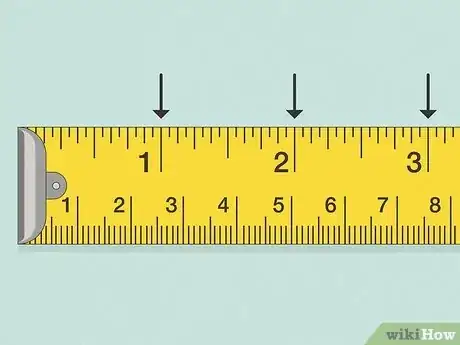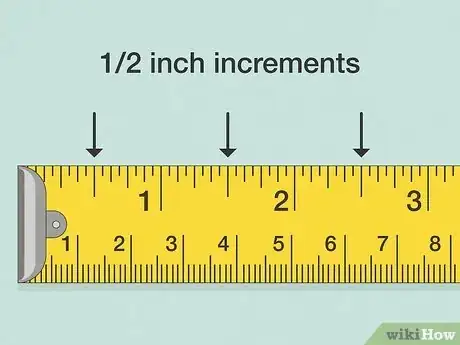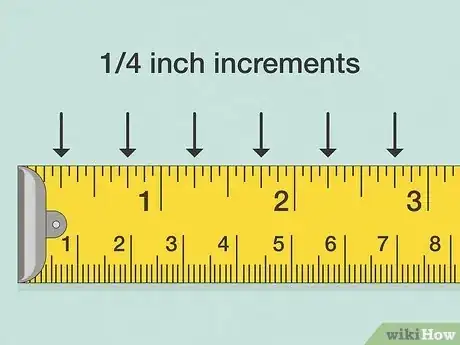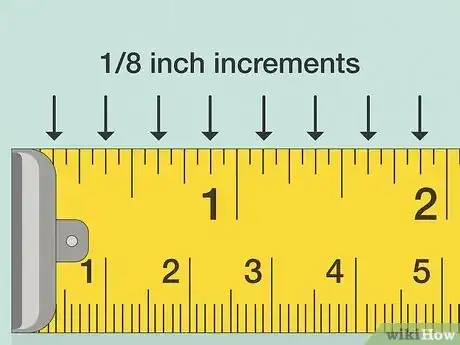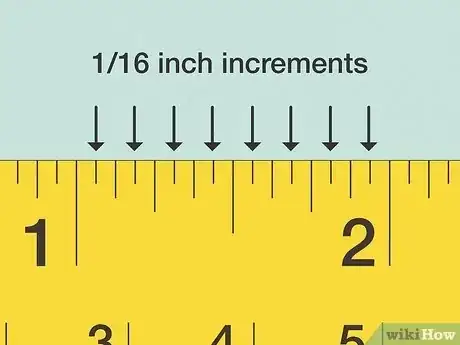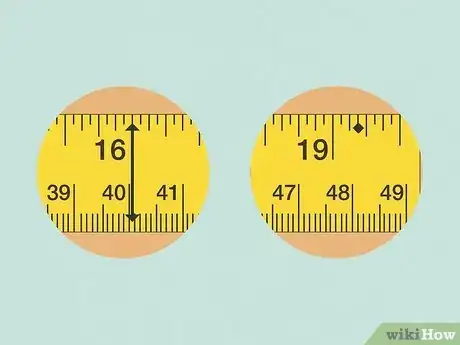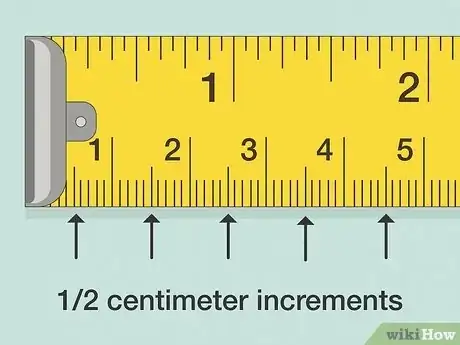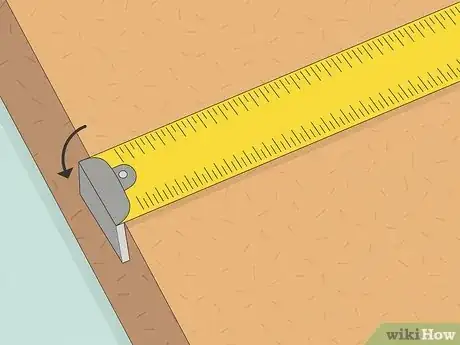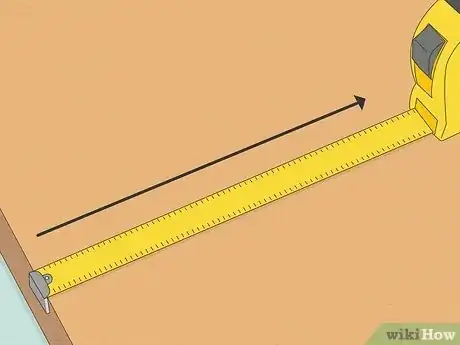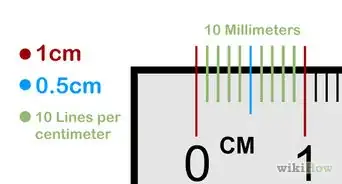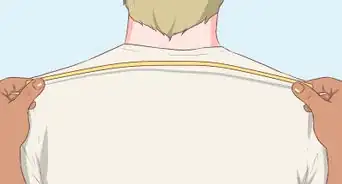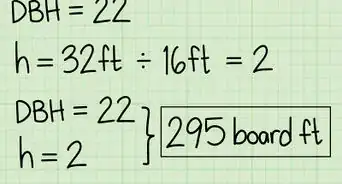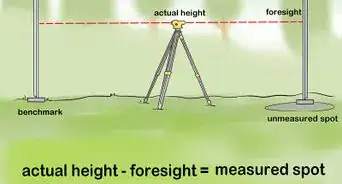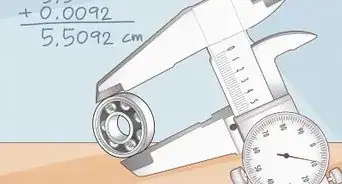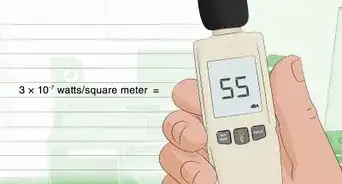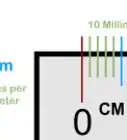This article was co-authored by Gino Colucci and by wikiHow staff writer, Hunter Rising. Gino Colucci is a Home Improvement Specialist and the Owner of Crackerjacks Handyman Services (not a licensed contractor) in Chandler, Arizona. Crackerjacks Handyman Services offers an effective cost-saving solution for commercial and residential repair and maintenance needs, specializing in smaller projects. Crackerjacks Handyman Services carries liability insurance and all technicians go through a background check.
There are 10 references cited in this article, which can be found at the bottom of the page.
wikiHow marks an article as reader-approved once it receives enough positive feedback. This article has 18 testimonials from our readers, earning it our reader-approved status.
This article has been viewed 3,194,624 times.
You need to take a quick measurement, but how can you decipher all the markings on your measuring tape? The lines on your tape measure make it easier to get a precise reading, and it's pretty easy to figure out how to read your measurement once you understand them. We'll walk you through what each line represents on your tape measure so you can accurately find the size of any object.
Things You Should Know
- For imperial units, use the longest marks to measure inches. Use the next longest lines for ½ inches, the third longest for ¼ inches, and so on.
- For metric units, measure centimeters with the longest markings. Use each of the smaller marks to find the length in millimeters.
- Stretch your measuring tape across the object. Find the nearest full measurement and add the length from the smaller markings.
Steps
Inches and Feet (Imperial)
-
1Find the longest, numbered lines to measure full inches. Pull out your measuring tape, and look for the long, thin lines with large numbers next to them. The length from one of the lines to the next one of the same size is always 1 inch.[1]
- Since 12 inches is the same as 1 foot, the number on the tape may be a different color or be labeled with an “F” to mark the length. After each foot marking, the numbers next to each inch mark will either repeat from 1 - 11 again or keep counting to 13, 14, 15, and so on. Each tape measure varies so be sure to check yours.
-
2Use the second longest marks to measure ½-inch increments. Find the ½-inch mark centered between the long lines marking out full inches. The line might be labeled “½” directly above it, but you can easily tell it’s the ½-inch mark if the only lines that are taller are the inch marks.[2]
- Unless it’s the first ½-inch mark on your tape measure, always add the full inch that came right before it to the measurement. For example, the half-inch mark between the 3- and 4-inch lines represents 3 ½ inches even if it isn’t labeled.
Advertisement -
3Recognize the third longest line as ¼-inch increments. Find the ¼-inch marks centered between the ½-inch and full inch lines. These markings are shorter (and sometimes skinnier) than ½-inch lines so you can easily reference the measurement at a glance.[3]
- Each inch is split into 4 ¼-inch increments. The 2/4-inch mark is the same as the ½-inch line.
-
4Check the fourth longest lines to find ⅛-inch increments. Look for the shorter ⅛-inch markings centered between each of the ¼-inch lines. Each inch contains 8 of the ⅛-inch increments, but the lines are usually not labeled with numbers. [4]
- The ¼-inch, ½-inch, and ¾-inch marks can alternatively be read as 2/8-inch, 4/8-inch, and 6/8-inch.
-
5Measure sixteenths of an inch with the smallest, densely-packed lines. If there are lines that are even shorter than the ⅛-inch markings, then each of them represents 1/16-inch. Find the 1/16-in marks perfectly centered between the ⅛-inch lines.[5]
- Some precise measuring tapes may have marks representing 1/32-inch or even 1/64-inch. When in doubt, count the total number of lines between the inch markings to know how far it’s subdivided. For example, if there are 16 total marks, then the smallest mark is 1/16-inch.
-
6Reference double arrows and diamonds for stud and truss spacing. Extend your tape measure and check every 16 inches for a set of 2 arrows. Since this is the standard distance between wall studs, you can easily extend the full tape and mark their locations. If you see a black diamond every 19.2 inches, you can easily reference them for standard locations to install roof trusses.[6]
- If you’re not measuring for wall studs or roofing, don’t worry about any of these markings since you won’t need to use them.
Centimeters and Meters (Metric)
-
1Find centimeters using the longest numbered markings. Look for the most prominent markings with large numbers next to them. The color of the number may be a different color every 10 centimeters so you can easily reference the length you’re measuring.[7]
- Every 100 centimeters, the number may be a different color or be labeled with an “M” to mark out 1 meter in length. After each meter, the centimeter markings may start over again at 1 or continue counting to 101, 102, and so on. This varies from measuring tape to measuring tape.
-
2Use the second longest lines to measure half-centimeter increments. Many metric measuring tapes have slightly shorter marks that are evenly spaced between each centimeter line. These marks are usually not labeled with a number.[8]
- The metric system is in base ten, which makes it much easier to work with decimals compared to fractions in imperial measurements. For example, write out 0.5 centimeters instead of ½ centimeters.
-
3Measure millimeters with the smallest, densely-packed markings. Each millimeter represents 1/10 of a centimeter, or 0.1 centimeters. Each centimeter contains 10 millimeters.[9]
- Metric tape measures rarely have units smaller than millimeters because it’s difficult to measure them precisely.
Taking Measurements
-
1Place the tape’s hook at the end of the object you’re measuring. Hook the metal piece at the end of the measuring tape onto the edge of the object so it doesn’t slip. If you’re measuring the inside distance, such as the distance across a door frame or from one wall to another, push the metal hook flat against the surface instead.[10]
- The hook may also be known as the “tang.”
- Does the metal hook feel loose? It’s supposed to! When you latch it onto an object, the hook pulls out so its width isn’t included in your measurement. When you push it up against the object on an inside measurement, the hook pushes flush against the tape so its width doesn’t affect your measurement.
-
2Stretch the tape across your object. With the hook and 0 mark in place at one end of the object, pull the tape measure back to let more tape out. Use one hand to hold the end of the tape in place as you stretch it to the full length.[11]
- Try to keep the tape as straight as you can since letting it sag can skew your measurement.
- If the end of your tape measure has a hole, hook it onto a screw or nail to keep the end from moving.
-
3Read the nearest mark to find the measurement. Look where the end of the object you're measuring lines up with a marking on the tape. Find the last full inch or centimeter mark on the tape. Then, count the marks between the full unit on the tape and the end of the object to find the full measurement.[12]
- Example: If you are measuring across the front of a dresser and the edge lines up right after the 24-inch marking, this means that your dresser is between 24 and 25 inches wide. If you count three ⅛-inch marks past 24 inches, then your dresser is 24 ⅜ inches wide.
- Example: If you’re measuring a piece of wood. The edge of the wood extends past 17 centimeters but not past 18 centimeters. If you count 7 millimeter marks past the centimeter line, then the piece of wood is 18.7 centimeters long.
-
4Use the lock switch to keep the tape at the same length. If you need to compare or transfer your measurement, slide the lock switch forward to keep the tape from retracting. When you don’t need the measurement anymore, then pull the lock switch back to feed the tape back into the case. The lock feature is helpful for:[13]
- Quickly seeing which of two objects is bigger
- Seeing whether something will fit through a certain space
- Keeping the tape available for multiple quick measurements
- Keeping a certain distance "handy" to avoid having to re-measure
Expert Q&A
Did you know you can get expert answers for this article?
Unlock expert answers by supporting wikiHow
-
QuestionWhat are the markings on a tape measure?
 Gino ColucciGino Colucci is a Home Improvement Specialist and the Owner of Crackerjacks Handyman Services (not a licensed contractor) in Chandler, Arizona. Crackerjacks Handyman Services offers an effective cost-saving solution for commercial and residential repair and maintenance needs, specializing in smaller projects. Crackerjacks Handyman Services carries liability insurance and all technicians go through a background check.
Gino ColucciGino Colucci is a Home Improvement Specialist and the Owner of Crackerjacks Handyman Services (not a licensed contractor) in Chandler, Arizona. Crackerjacks Handyman Services offers an effective cost-saving solution for commercial and residential repair and maintenance needs, specializing in smaller projects. Crackerjacks Handyman Services carries liability insurance and all technicians go through a background check.
Home Improvement Specialist
-
QuestionWhat are the black diamonds on a measuring tape?
 Gino ColucciGino Colucci is a Home Improvement Specialist and the Owner of Crackerjacks Handyman Services (not a licensed contractor) in Chandler, Arizona. Crackerjacks Handyman Services offers an effective cost-saving solution for commercial and residential repair and maintenance needs, specializing in smaller projects. Crackerjacks Handyman Services carries liability insurance and all technicians go through a background check.
Gino ColucciGino Colucci is a Home Improvement Specialist and the Owner of Crackerjacks Handyman Services (not a licensed contractor) in Chandler, Arizona. Crackerjacks Handyman Services offers an effective cost-saving solution for commercial and residential repair and maintenance needs, specializing in smaller projects. Crackerjacks Handyman Services carries liability insurance and all technicians go through a background check.
Home Improvement Specialist
Warnings
- Avoid letting the tape snap back quickly into the case since it could hurt you. Slowly feed the tape back into the case instead.⧼thumbs_response⧽
References
- ↑ Gino Colucci. Home Improvement Specialist. Expert Interview. 14 January 2021.
- ↑ https://5.imimg.com/data5/GW/LJ/AM/SELLER-2044578/freemans-measuring-tapes.pdf
- ↑ https://www.bobvila.com/articles/how-to-use-a-tape-measure/
- ↑ https://youtu.be/TWH8HVqkHP4?t=158
- ↑ https://www.bobvila.com/articles/how-to-use-a-tape-measure/
- ↑ https://youtu.be/p26QdnP27tg?t=60
- ↑ https://www.accessibilityguides.org/sites/default/files/pictures/How-to-take-accurate-measurements-for-your-accessibility-guide3.pdf
- ↑ https://www.bobvila.com/articles/how-to-use-a-tape-measure/
- ↑ https://youtu.be/kJzil8ASw-k?t=63
- ↑ Gino Colucci. Home Improvement Specialist. Expert Interview. 14 January 2021.
- ↑ https://5.imimg.com/data5/GW/LJ/AM/SELLER-2044578/freemans-measuring-tapes.pdf
- ↑ https://www.unl.edu/synergycurriculum/Documents/Prevocational-Instructors/Teacher%20Module%202,%20Unit%201.pdf
- ↑ https://www.bobvila.com/articles/how-to-use-a-tape-measure/
- ↑ https://undeniablebajinya.com/wp-content/uploads/2020/12/taking-measurements.pdf
- ↑ https://youtu.be/dMN2Ll4-x40?t=202
About This Article
To read a measuring tape, line the zero mark up at the edge of the item you're measuring, then stretch the tape all the way across the item. Try to keep the tape straight to ensure an accurate measurement! Then, look at the point where the tape meets the end of the item you're measuring and read the nearest large number. The large numbers are the units you're measuring, like inches or centimeters, and the markings between the large numbers correspond to fractions of that unit. To learn about the differences between the imperial system and the metric system, read on!
